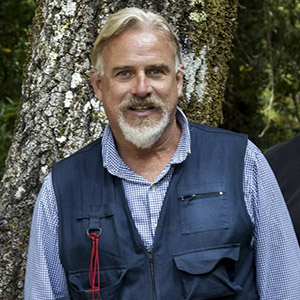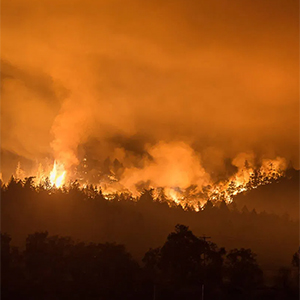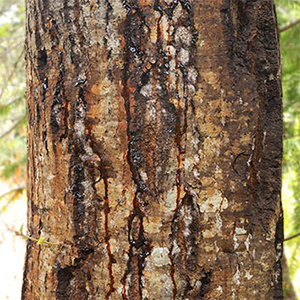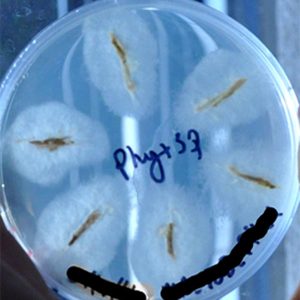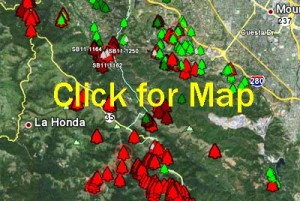Most likely the redwood is experiencing symptoms related to cycles between drought and rainy periods. However, if there is a significant presence of California bay laurels intermixed with redwoods, there may be enough pressure from the SOD pathogen to also cause problems on redwoods, both native and exotic. Any SOD oak infections are likely directly connected to bay laurels, as both oaks and redwoods can become infected by the large number of spores produced on bay laurel leaves. The pathogen does not move from oaks to other trees.
Take the following precautions when using local acorns for oak reforestation projects in areas impacted by SOD to help minimize pathogen spread.
- Place acorns in a 10% dilution of bleach for 10 minutes then rinse twice with tap water.
- Make sure volunteers’ shoes are free of soil, mud, and organic material.
- Be sure tools being used are clean and free of soil, mud, and organic material.
The most important part of ensuring that tools will not spread sudden oak death is to be sure that no organic debris or soil is present on the tool. This applies to all portions of the tool, including parts that may not be visible (like the return of a chain in a chainsaw or the interior of a tree chipper).
Phosphonate injection treatments to help prevent sudden oak death infection of susceptible oak species (coast live oak; California black oak, Shreve’s oak, and canyon live oak), if applied in the fall (after October 30th ), need only to be applied once every other year (biannual frequency). If your first phosphonate treatment is in the spring, then treat again in the fall (after October 30th) and then treat once every other year.
If applying phosphonate as a bark application in conjunction with the surfactant PentraBark®, then one fall treatment each year is the prescription. If you apply it the first time in the spring, apply again in the fall after October 30th and then apply again in the fall of each year (after October 30th).
The most important part of ensuring that tools will not spread SOD is to be sure that no organic debris or soil is present on the tools. This applies to all portions of each tool, including parts that may not be visible (like the return of a chain in a chainsaw or the interior of a tree chipper). For more information on cleaning tools and equipment, go to https://nature.berkeley.edu/garbelottowp/?p=1208.
When looking at SODmap, you may wonder if P. ramorum-positive trees are close enough to pose a threat to trees on your property. Use the free App SODmap mobile to get the answer. Just tap the App risk function and it will tell you whether infected trees trees are within 200 m (high risk) or 1,000 m (moderate risk). If infected trees are further than 1,000 m, risk is typically low. Alternatively, you can use Google Earth, tapping the icon with a “ruler” on the top bar. Click your mouse on the closest infected tree and then move the mouse to your property. Be careful to actually move the mouse all the way to an oak tree within your property. The mouse should be drawing a line when you go from the infected tree to your oak. When you click the mouse again on top of the oak on your property, the ruler will tell you the distance. The following is suggested:
1- As the crow flies, measure from any infected tree to any oak of interest.
2- Repeat the measurement process using 3 different infected trees that appear to be close to your property.
3- If distance is slightly higher than 200 m (high risk) or 1,000 m (moderate risk), but your property is downhill and/or downwind, you may still consider your oaks to be at risk.
It is always advisable to first have a tree tested before removal to be sure P. ramorum is present. If you are noticing symptoms in spring, attend a nearby SOD Blitz for information on sampling and lab submissions. For more information, go to sodblitz.org.
Bay shoots do not carry P. ramorum because the pathogen is not systemic in bay. Each leaf is infected independently. Additionally, there is no root infection in most P. ramorum hosts, particularly California bay laurel. However, when bays re-sprout, they may be re-infected.
When treating oak trees with phosphites to help prevent SOD, it may be beneficial to apply the topical treatment to bark that is dry. Rain occurring after the treatment (even immediately after) does not affect the application. If injecting phosphites, it may be better to avoid rainy days, as lower evapotranspiration is often documented for trees in such conditions. Lower evapotranspiration rates may result in poor tree absorption of phosphites.
Note: Topical treatments are most effective when applied in the fall, from November to early December. Injections should only be performed from fall to early winter.
When trying to determine if an oak may have SOD (caused by the plant pathogen Phytophthora ramorum), the first step is to determine if the tree lies within 1 km of a known outbreak. This can be done by accessing SODMAP at www.sodmap.org or by uploading the free “SODMAP Mobile” app to your smartphone. Stand next to the tree in question and tap the risk button. A response of moderate or high risk would suggest Phytophthora ramorum may be present. The next step is to confirm it is indeed P. ramorum. Make sure the oozing is not wetwood, or bacterial flux, which typically is associated with much more oozing and often has an unpleasant odor. Bacterial flux usually has a watery secretion running down the trunk that originates from a wound or branch crotch. If all symptoms align with SOD, the next step is to test for P. ramorum. If a symptomatic California bay laurel tree is within 10 m of the oak, collect symptomatic bay leaves for testing. This is not a definite diagnosis for the oak, but it may be an acceptable one that does not involve wounding the oak tree for sampling. Bay-based diagnosis for an oak may be less accurate after multiple years of drought, as bays may actually turn from SOD positive to SOD negative during extended dry conditions. One can get bay leaves tested by participating in one of the annual SOD blitzes (www.sodblitz.org) or by submitting samples to the California Department of Food and Agriculture. Testing the oak requires debarking a portion of the tree until the margins of the putative SOD lesion under the bark are visible and then plating the margins of the lesion on Phytophthora-selective medium for laboratory analysis.

